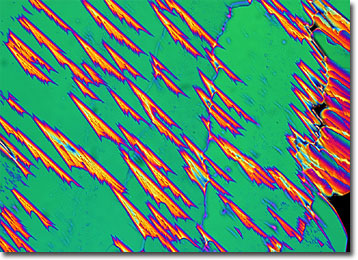Polarized Light Microscopy Digital Image Gallery
Ethidium Bromide
Commonly utilized in molecular biology and biochemistry laboratories around the world, ethidium is best known in its bromide form. Though the substance is pharmacologically active, it is most familiar as a nucleic acid stain and a component of electrophoretic gels.

View a second image of Ethidium Bromide
Ethidium bromide, also sometimes referred to as ethobromide, homidium bromide, and dromilac, appears as dark red crystals when it is pure and dry. When utilized in the laboratory, however, and examined under either long or short ultraviolet (UV) wavelengths of light, a reddish-orange fluorescence can be easily detected. A relatively large, flat molecule, ethidium bromide appears somewhat similar to a DNA base pair and can easily insert into strands of the material due to its chemical structure. Thus, when bound to double-stranded DNA molecules, increased fluorescence of ethidium bromide occurs.
Despite the usefulness of ethidium bromide, many other fluorescent dyes have been developed for detecting nucleic acid components in recent years. The reason for this progression is largely due to the fact that ethidium bromide use is plagued by many possible hazards. For instance, although it is not regulated as a hazardous waste, the material is a possible carcinogen with strong mutagenic and poisonous properties, so it should always be handled with great care and be disposed of as a biohazard. Moreover, inhalation of ethidium bromide dust could cause serious side effects since the stain is known to be a severe respiratory irritant. Dermal contact with the substance, which should also be avoided, is easy to detect in the laboratory because a light to deep purple stain that forms on the skin is readily observable.
